Kettles & Samovars
Kettles & Samovars
Browse our collection of antique silver Tea Urns, Tea Kettles and Samovars. These practical items were used in the 18th and 19th centuries to replenish the teapot with hot water.
Silver Tea Urns, also known as samovars, They were not usually found before about 1765 and the early ones were heated with charcoal. About 20 years later more sophisticated designs were produced after the introduction of a pre heated iron rod which could be placed into the tea urn within a central tube. By the year 1800 the use of spirit lamps underneath the urn became popular. Smaller urns were also made for coffee and these normally didn’t have a heating device.
Silver Tea Kettles date from Queen Anne times. Tea kettles were used to refill the teapot for guests and family while tea was being served. They were made until the 1770’s when the tea urn took over the job of providing hot water. Although kettles were still made between 1770 and 1840 they were less common until Victorian times when they were reintroduced, probably because of the discovery of odourless spirit for the burners
-

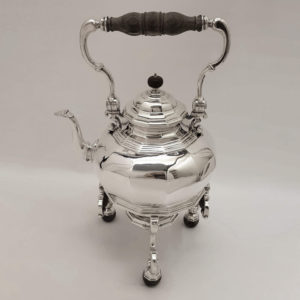
Circa 1720
Paul de Lamerie
9720 George I Silver Tea Kettle
Sold
A large and imposing antique silver samovar of plain design having a wooden swing handle and 12-sided baluster design. By the sought after Huguenot silversmith Paul de Lamerie. Britannia standard silver*. Very heavy gauge silver. The matching burner stand has carrying handles and stands on large wooden ball feet; it has a removable burner well with push on top and flip cap for the wick. Excellent colour and hand hammered finish. A nice feature is the hinged cover to the pouring spout. Engraved with a crest and name “Riversdale W.G”. Weight 3696 grams, 118.8 troy ounces. Total height 44cm (handle extended). London circa 1720. Maker’s mark stamped 4 times for Paul de Lamerie (Britannia mark).
-

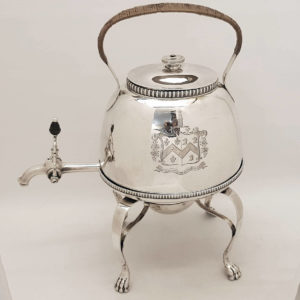
1810
John Edwards III
9998 George III Antique Silver Kettle
A handsome antique sterling silver samovar of oval form with a wicker wrapped loop handle. The matching stand on four lion paw feet contains a double burner. Plain style with an expansive hand engraved armorial to the front for the Ramsden and Fullerton families. A charming feature is the little turned wood tap finial in the form of an acorn. Total weight 2518 grams, 80.9 troy ounces. Total height 41cm. London 1810. Maker John Edwards III.
-

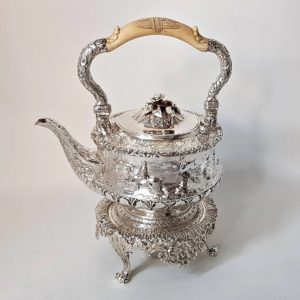
1825
Benjamin Smith
9823 Georgian Silver Tea Kettle
Of sporting interest. A magnificent antique sterling silver tea kettle (also known as a samovar or hot water kettle) with a scene of horses hunting to hounds. The kettle is all over decorated with flowers, foliage, scrolls and cast borders. It has a pretty flower lid finial and folding ivory handle. The matching silver tea kettle stand has an ornate cast and pierced frieze with flowers and leaves; the integral burner has a detachable cap to insert the oil and wick. An excellent piece with heavy gauge silver and good colour. Hand engraved to the top of the burner is a stag crest. Contains 1400 ml. Total weight 1945 grams, 62.5 troy ounces. Total height 31.5cm (to top of handle), 23cm (to top of kettle). London 1825. Makers Benjamin Smith and Richard Sibley.
Recently Viewed Products
-

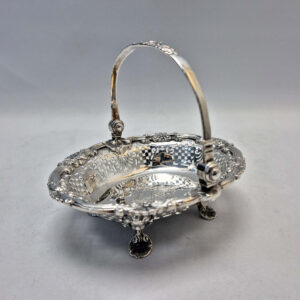
1749
James Morrison
10436 George II Antique Silver Basket
A delightful little miniature George II silver swing handled sweetmeat basket of oval form. Very small size. The quality is excellent with heavy gauge silver and good colour. The handle and border are expertly cast with finely executed shell, scroll and flower decoration. The body has pierced lattice design, the centre hand engraved with an armorial within a decorative cartouche. The cast feet have interesting figural face masks standing on shell feet. Weight 316g, 10.1 troy oz. Height 12.2cm, 4.8ins (total including handle), 4.8cm, 1.9ins (basket only). Top measures 14.8cm, 5.8ins x 12.7cm, 5ins. London 1749. Maker James Morrison. Sterling silver.
-

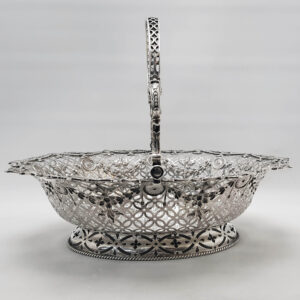
1771
William Plummer
10346 George III Antique Silver Basket
A handsome antique silver basket of oval form with swing handle and applied oval foot with rope trim. Lovely decorative detail with embossed swags of harebells and classical medallions. Excellent quality hand cut pierced work to the body. Very good size and colour. Hand engraved to the centre is family coat of arms within a finely executed floral cartouche. Weight 1148 grams, 36.9 troy oz. Height 28cm (total including handle). Top measures 35.5 x 29.5cm. London 1771. Maker William Plummer. Sterling silver.
-

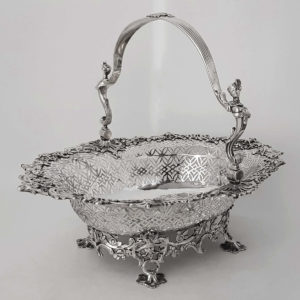
1758
Samuel Herbert And Company
9835 George II Silver Basket
A magnificent George II silver basket of oval form with excellent quality hand cut pierced work and a Chinoiserie theme. This really is a very fine example. Both the upper border and bottom frieze are cast with flowers, scrolls, and Chinese face masks. The swing handle has a cast figure of a Chinese lady to both sides. The centre is beautifully engraved with a coat of arms within a large decorative cartouche. Very good weight and colour. Weight 1770 grams, 56.9 troy oz. Height 30cm (total including handle), 12cm (basket only). Top measures 38 x 32cm. London 1758. Maker Samuel Herbert & Co. Sterling silver.
-

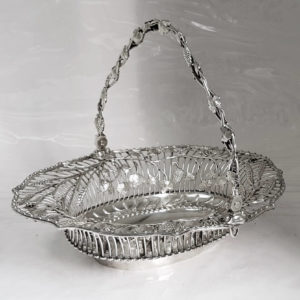
1760
Arthur Annesley
9745 George III Silver Basket
Sold
An early English silver basket of oval form with a fruiting vine decorated swing handle and traditional bead borders. First year of George III’s reign. Very heavy weight. The attractive wirework design has applied decoration of vine leaves, bunches of grapes and wheat stalks which have been stamped and chased and then soldered onto the wires. This type of ornament shows that this basket would originally have been used for fruit or bread. Weight 1369 grams, 44 troy ounces. Height 28 cms to top of handle). Top measures 35.5 x 30 cms. London 1760. Maker Arthur Annesley. Sterling silver.